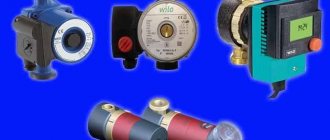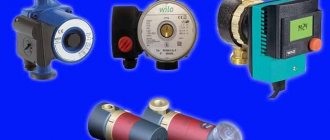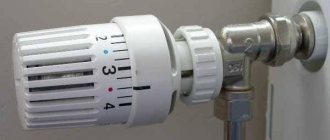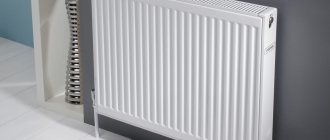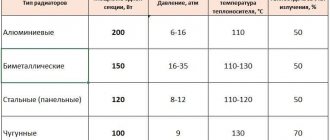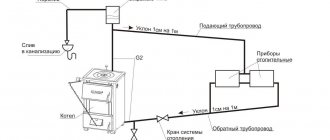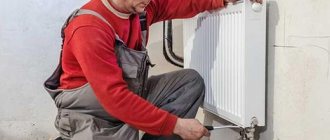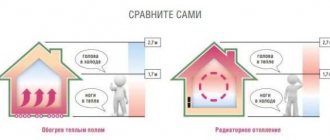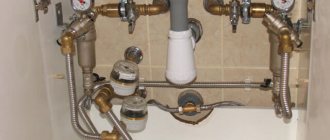Connection diagrams
Before installing a heating radiator yourself, decide on the method of connecting it to the network. The most commonly used schemes are:
- Lateral (one-sided) installation scheme for heating radiators, in which the pipe supplying hot coolant is connected to the upper pipe of the heating device. The outlet pipe is connected to the bottom one. This ensures high heat transfer. When connecting the other way around, when the supply pipe is connected from below and the outlet pipe from above, the heat transfer is significantly reduced. Such a connection in a one-pipe system requires the installation of a jumper to facilitate the operation of the system.
- The second, diagonal connection of the heating radiator is as follows. The pipe supplying hot coolant is connected to the upper branch pipe of the battery, and the “return” is connected below, on the opposite side of the heating device. This connection is advisable if the battery is long and has a large number of sections. The diagonal design guarantees maximum heat transfer. But if the supply pipe is connected from below and the outlet pipe from above, the heat transfer will decrease by 6-10%.
- The last method - connecting heating radiators from below - is used when the consumer wants to hide heating pipes in the wall, in the floor or near its surface. With it, the forward and return pipes are connected from the bottom of the radiator, but from different sides. This connection scheme (otherwise called “Leningradka”) is characterized by aesthetics, as well as low heat transfer. Heat loss is up to 15%.
You can ask the specialists how much it costs to install a heating radiator, and perhaps agree to their services. Experienced craftsmen will tell you which connection scheme to choose and what auxiliary elements will be needed for installation.
To do this, first drain the coolant from one radiator, which is changed if it can be localized by closing the valves at the inlet; or from the entire one-pipe system. When carrying out work in an apartment building, you should contact the housing department so that its employees drain the water from the riser on which the replacement is being carried out. After this, you can remove the old radiator.
To install a heating radiator yourself, you first need to install shut-off and control equipment on it.
After installation, the connections need to be crimped.
Having familiarized yourself with how to properly install heating radiators, you should think about whether you need to do this work yourself. If you do not have the skills to install heating devices, it is better to hire professionals, having previously found out the prices for installing heating radiators in the locality where they will be installed.
From all of the above it follows that the installation of heating batteries can be quite simple if you initially prepare well for it and study all the instructions supplied with the device. After completing all procedures in the established sequence, the heating system will be durable and will last for decades.
Single pipe heating
A single-pipe heating system is the simplest and cheapest design to install. This wiring scheme is usually used in multi-apartment buildings, but it is also sometimes found in private houses. In a one-pipe system, radiators are installed according to a series connection scheme, i.e. The coolant passes through the heating devices one by one. From the last radiator, the cooled coolant returns to the heating boiler or riser.
The key disadvantage of the single-pipe scheme is the uneven heating of the installed radiators and the inability to control their heat transfer. Installing a regulator on one battery leads to adjustment of a further section of the circuit. Batteries located far from the boiler receive much less heat - it simply remains on the previous devices. Even if you know exactly how to connect the battery correctly, uniform heat transfer in a single-pipe system cannot be achieved.
The installation process itself
Before starting work, it is necessary to completely shut off the heating circuit, drain the water from the system, and the pump will help remove any remaining water efficiently. Using a level, carefully check the battery hung on the supports vertically and horizontally.
- You need to unscrew all plugs from the device.
- Connect a valved bypass, which is only required for a single-pipe circuit. To connect to a two-pipe circuit, a bypass is not needed; only a squeegee with a valve connected to it is used for connection.
Using threaded connectors, we connect the battery to the system, using tow or another sealant to seal the joints (if you have experience in welding, the joints between the connectors and the pipeline can be welded).
It is important to note that until the installation is completed from aluminum. bimetallic and steel devices do not need to remove the packaging shell
Installation is complete, but some more pressure testing will be required. To do this, you will need to call a plumber. Both his experience and the device will be useful, which does not make sense to buy for the sake of installing several batteries.
Fasteners for steel heating devices
There are two different types in this group: tubular and panel radiators. They have different designs and, accordingly, different fastenings.
In panel radiators, brackets are welded on the rear wall, with the help of which they are hung on brackets. The shape of this type of fastener is different: it is designed specifically for staples.
In panel radiators, brackets are welded on the rear wall
When installing panel radiators, it is necessary to strictly monitor the vertical position of the brackets. High precision required: four or six staples must fit exactly onto the hooks
It is also important that the wall is perfectly flat and smooth. In general, using conventional brackets, panel radiators are quite difficult to hang
It is easier to work with other types of holders.
Standard bracket for panel radiator
Since the mass of the heating device is small, it is quite enough to fix it on the upper brackets and install stops at the bottom that will give it direction in the horizontal plane. They are not attached to the wall, but are hooked onto a bracket and simply rest against the wall. For reliability, the part that faces the wall is expanded.
This is what a set of brackets for tubular steel batteries looks like: the upper collector is hung on the hooks, and plastic stops are placed below
There are also special mounting strips for easy installation. They are a strip of metal with plastic clips at the top and bottom. When using this fastener, there is no need for brackets on the rear panel. The slats are fixed to the wall, a radiator is inserted into them, which is held in place by plastic hooks.
Rail for quick installation of panel batteries
Fasteners for tubular radiators are similar to sectional ones: the same hooks, only of a different size, often equipped with plastic covers.
There is also a special fastener with SMB tube grips. This is a strip of steel with plastic clips and a shelf at the bottom that serves as a support for the radiator. This mounting plate can be used if the weight of the device filled with water does not exceed 100 kg. Installation is simple: place the battery on the shelf, bring the top edge closer to the latches. They grab the nearest tube and a click is heard. The radiator is installed, the supply pipes can be connected.
Bar for quick installation of a tubular radiator with shelf and clamps
There is a second option for quick installation: SVD fasteners. It consists of two parts. One is attached to the radiator, the second to the wall. Then they are connected to each other and secured with a steel loop.
Another type of holder for tubular models: two parts, one is attached to the wall, the second is attached to the pipe. They are held together with a wire fastener.
Floor mounting for tubular radiators can be of several types: tubular supports that are welded at the factory, or stands with hooks. Radiators are hung on such racks, and the racks themselves are attached to the floor.
https://youtube.com/watch?v=VkAVZDnvz6w
Brackets for radiators are of different types and types: for wall and floor installation. The standard ones that come with the kit are reliable, but they are more difficult to work with. Planks and devices for quick installation save time, but cost a lot.
Classification of heating batteries
To understand what heating devices are, you need to study their classification. Types of radiators are distinguished depending on the material of manufacture:
- cast iron;
- steel;
- aluminum;
- bimetallic.
Each type has its own advantages over other models. Therefore, it is difficult to say that any of them is definitely better.
Cast iron models
Batteries made of cast iron are massive, have the ability to retain heat for a longer time, and are not susceptible to corrosion. A definite plus is resistance to large pressure surges. Cast iron radiators are the most suitable option for apartment buildings. The service life is at least 50 years, sometimes longer. Instead of regular models, you can install ones decorated with patterns.
It is worth considering that due to the large mass, it is necessary to select a reinforced mount for cast iron heating radiators.
Steel radiators
A steel battery is a steel casing, inside of which there are plates and pipes made of the same metal. Structures are divided into panel and tubular. A well-thought-out structure allows air to actively circulate, so the room quickly warms up. But the device cools down quickly after the heating supply is stopped, which can be considered a significant drawback. Due to its low weight, mounting the radiator to the wall is not particularly difficult. Compared to cast iron representatives, steel appliances consume one third less coolant, which makes them very economical.
Aluminum radiators
The complex design of the convector allows for efficient circulation of air masses. The thermostat quickly responds to commands, which allows you to change the room temperature in a short time. Depending on the production method, structures are divided into injection molding and extrusion. The first ones are of better quality, but expensive. The latter are cheaper, but cannot be repaired. They are relatively lightweight, which greatly simplifies the installation process. These batteries look attractive, but are not very easy to clean.
Bimetallic radiators
An improved version of aluminum batteries is bimetallic. The system is reinforced with steel elements, which make them resistant to higher pressures. Convectors quickly warm up and begin to give off heat. They weigh a little, making them easy to install. The surface is easy to clean from various contaminants, unlike cast iron models. These devices are more resistant to corrosion. But bimetallic heat exchangers are more demanding on the quality of incoming water.
Radiator installation
Those who are wondering how to hang a heating radiator without the help of professional plumbers need to know what steps this process involves. So, you need:
- prepare equipment and materials;
- calculate location;
- install brackets;
- hang the radiator;
- seal or solder the joints;
- check the entire system for functionality.
We purchase the necessary materials and equipment
To begin with, it should be noted that it is not recommended to install radiators in winter.
And even if you decide to install heating yourself, in any case you need to call a plumber who will disconnect your apartment from the riser. To fix the radiator on the wall, you will need such components for heating radiators as: corners, bushings, nipples, brackets, brackets, couplings, adapters, tow, valves, keys. If you plan to install cast iron batteries, you also need to purchase Mayevsky taps, designed to bleed air from the heating system and prevent airing. Aluminum and bimetallic radiators are equipped with them initially.
Calculating the location
This stage is important to ensure that the heating device works at full capacity and does not collect air. To do this, sections of underwater pipes should be installed at a slight slope relative to the floor. The minimum slope is 0.5 cm. Here are the optimal battery location parameters:
- 3-5 centimeters from the wall;
- 10 centimeters from the floor;
- 5-10 centimeters from the windowsill.
If the selected type of battery does not have high heat dissipation, you can also install a heat-reflecting tap on the wall behind the battery. It is usually made of insulating material or a special heat-reflecting substance that is applied to the wall.
Installing brackets
Brackets are mounts for heating radiators in the form of durable metal hooks installed inside the wall.
It is easy to calculate the number of brackets: 1 piece per 1 m2 of battery. Of course, even if the entire battery area does not exceed 1 square meter, you will still need two brackets, since fixing the structure on one will be very unreliable. Now you need to mark their location: we use a tape measure and a level for this.
Then we drill holes in the wall, install special dowels in them, tighten the fasteners for the heating radiators and use our hands to make sure that the brackets sit tightly and do not wobble. If the choice fell on cast iron radiators, you may need a special mount for cast iron heating radiators - floor support elements in the form of legs. They will help distribute the weight evenly across all fastenings.
Installing the radiator
The last stage of radiator installation. We hang the battery and check how tightly it fits, whether the weight of the structure is distributed equally across all fastenings. Try to shake the radiator a little: if the fixation is strong enough, you can move on to the next step.
Connection and assembly of connections
There are three different radiator connection schemes:
- lateral one-sided. The most popular option. The inlet pipe is connected to the upper pipe, and the outlet pipe is connected to the lower pipe on the same side;
- diagonal connection. More suitable for long radiators in large rooms and ensures uniform heating of the entire battery. The inlet pipe in this scheme is connected to the upper pipe on one side, and the outlet pipe to the lower pipe on the other;
- bottom connection. It is used in cases where the heating system is hidden in the floor. Both inlet and outlet pipes are connected to the lower pipes from different sides. Heat transfer with a bottom connection is approximately 10% less than with a side connection.
Let's start assembling the connections. Regardless of which heating radiator fittings you purchase, you must carefully seal each connection.
Any leak can literally and figuratively result in additional repair costs.
Special tapes, silicone, sealant or good old tow are used as seals. If the purchased battery is protected with a special film, it is better to remove it only after thoroughly crimping each connection.
Now all that remains is to return the water supply to the heating system and carefully check all connections for leaks.
Basic subtleties of work
The type of heating system plays an important role in the entire operation. With single-pipe heating, a bypass will be necessary, allowing, if necessary, to turn off individual sections of the heating system. To work on mounting radiators, you will need to prepare all the necessary tools and materials:
- plugs and stoppers;
- dowels;
- taps and brackets;
- construction level and hammer drill.
When attaching radiators to the wall, you should follow some rules to do the job as efficiently as possible. First of all, the following dimensions must be observed:
- Be sure to take into account the distance of the structure from adjacent surfaces. So, the space from the floor to the radiator should remain at least ten centimeters. Approximately the same distance should be maintained from the batteries to the windowsill for uniform air distribution.
- The distance from radiators to walls must be maintained within three centimeters.
In addition, you should take into account other nuances that allow you to correctly fasten the elements of the heating system:
- Square footage of the room. The number of sections of the heating device depends on this parameter, which plays an important role when mounting.
- The number of brackets must be chosen with reserve. It is advisable to use at least three brackets: two on top and one on the bottom. But it is best to use four, two at the bottom and two at the top. If the battery size exceeds 10 sections, it is recommended to increase the number of brackets to six.
How to choose the right bracket
The main rule when buying a retainer: it must withstand the weight placed on it. The maximum load is usually indicated in the included instructions. It is easiest to choose a bracket for an aluminum radiator, since it weighs little and any type is suitable for it.
For very powerful batteries, use floor stands. But if the covering in the house is wooden, then you need to make sure that the clamps are equipped with additional fasteners to the wall. This is necessary in order to reduce the load on the boards. For light heating elements that will be located in a deep niche under the window, it is better to buy a long bracket.
For cast iron radiators, it is recommended to use holders with the ability to slightly change the height, otherwise installation difficulties may arise. The price of an adjustable bracket is not so high as to give up installation convenience.
It is important that the alloy contains no toxic substances released when heated. You should not buy parts secondhand, especially without the appropriate accompanying documents.
Please note that the lightest one - the corner bracket - is intended only for aluminum and copper radiators
Required tools and materials
Technology for unscrewing and assembling cast iron batteries: a – nipples capture the threads of sections (2-3 threads); b – tighten the nipples, join the sections; c – install the third section; d – two radiators are grouped.
Replacing or installing various cast iron radiators can occur in several stages and in completely different ways. To carry out this installation, you will need:
- gloves;
- protective glasses;
- gas welding;
- mounting keys;
- rubber gaskets;
- screwdrivers;
- radiator keys (short and long).
If you decide to install or replace it yourself, be very careful and follow the technical and safety rules. Welding work can be harmful.
Problems of insufficient fastening of batteries to the wall
Correct and reliable fastening of heating devices to the wall is a guarantee of peace and well-being of apartment residents. Insufficient fixation of batteries, especially in combination with the following factors, can lead to deformation of the product or depressurization of seams, which will cause leaks
That is why it is very important to install them correctly and reliably.
So, the factors that aggravate the improper fastening of batteries:
- mechanical damage to devices during their operational life;
- distortions of heating radiators when filling them with water.
What is needed to connect radiators
Creating a heating system is a rather complex process. Meanwhile, by following all the rules and a clear sequence of work, even a beginner can cope with it. How to connect a heating battery correctly? The main thing is attention. For high-quality installation and connection of radiators, some components are required. In particular:
How to assemble or remove a heating battery
- adapters with right and left threads (fittings);
- tools for high-quality screwing of adapters;
- plugs, manual air vent, key for bleeding air, adapters;
- shut-off valves, ball valves, valves;
- pipes.
Heating radiator installation kit
Some subtleties of hanging a radiator, advice from experts
After installing the radiator on the installed fasteners, it is necessary to check the correctness of its placement in the horizontal and vertical planes.
Checking the correct placement of the radiator in horizontal and vertical planes
It is allowed to lift the edge of the radiator on which the air vent is located. This will ensure that the air trapped in the system accumulates at the highest possible point, and its release will be carried out quickly and with maximum efficiency.
Air vent for radiator
But a change in level of more than one centimeter is unacceptable, as is a reverse tilt. In this case, the formation of an air lock is guaranteed, and the supply of coolant further along the pipeline will be limited or stopped.
Advice! Almost all companies producing heating devices require installers to install only on pre-prepared walls. That is, the surface must be smooth and clean. This will allow you to correctly mark the locations for fasteners.
The heating radiator is hung on two hooks (brackets), which are located in the upper part, and the third must be installed as a support for the lower edge of the device. The installation worker must remember that the number of brackets is determined by the weight and length of the battery.
Operating principle of radiator heating systems
What could be simpler than heating radiator connection diagrams? There is a boiler: solid fuel, diesel, gas, etc. The coolant is heated in the boiler, which gets there under the action of a pump. The heated coolant goes into the radiator heating system; in the radiators, heat is transferred to the surrounding air. The coolant cools down and, already cooled, returns to the boiler, where it heats up again and so the circle is closed. Everything is very, very simple, but, nevertheless, in reality, schemes can be much more complex. Let's see what these schemes are and how they differ from each other, let's look at their advantages and disadvantages.
How to install a heating radiator
You need to hang a heating radiator on a wall or in a niche after the surface has been completely puttied. However, to do this, connections for radiators must be removed from the wall or niche in advance. Depending on the type of connection of the heating batteries, these can be either chrome-plated tubes or simply metal-plastic or plastic pipes.
To install a heating radiator on a wall, you must first carry out the marking work correctly. To do this you will first need:
- Roulette and building level;
- Pencil;
- A long rule or a piece of even profile;
Before installing a heating radiator with your own hands, you must decide on its height, as well as how the radiator will hang, in a niche or under a window. According to the rules, heating radiators in niches are installed in the center, and under the windows on the other side, as low as possible from the floor. If we talk about the height of the heating radiator at which it should be installed, then this distance does not exceed 15 cm from the finished floor covering.
After all the above questions are completed, you can hang the heating radiator on the wall. The first thing to do is measure the distance from the window slopes or niche edges. The resulting size must be divided in half. This must be done in order to find the center.
Then a vertical line is drawn from the resulting markings, from which further markings will be made for installing the heating radiator. Depending on the type of heating device, its installation on the wall can be different, and this applies not only to the dimensions between the fastening elements.
How to hang an aluminum radiator on the wall
To hang an aluminum radiator on the wall, you need to move two sections towards the middle from each edge of the radiator. Thus, it will be clear between which sections the fasteners will be installed to fix the aluminum radiator to the wall.
Then you should measure the distance from the installation locations of the fasteners, and then transfer them to the wall. Using the marks obtained, holes are made in the wall for installing dowels in them and subsequent installation of fastening elements for the heating radiator.
How to hang a metal radiator on the wall
Panel heating radiators (metal) can be hung on the wall using a slightly different scheme. Initially, everything happens as in the first stage of installing an aluminum heating radiator. You need to find the center under the window, and then decide on the height of the radiator from the floor.
The fastening elements of the metal heating radiator are welded to its rear side. Therefore, the dimensions when installing a radiator on a wall are fixed here; they cannot be increased or decreased as, for example, when installing an aluminum radiator in one or two sections in the middle or to the edges.
In addition, to install a metal radiator on the wall, small fasteners are used rather than such long hooks. You should first measure the distance from the middle of the fasteners on the metal radiator, and then transfer them to the wall and install the heating radiator yourself.
How to hang a heating radiator on drywall
You should know that when installing a heating radiator, you need to take into account the material from which the wall on which the heating radiator will be hung is made.
It often happens that when drilling, the drill gets into a brick seam, and after that the dowel does not want to stay in the hole normally. In this case, you can go in two ways: hang the radiator higher or lower, or seal the resulting hole with putty, and then try to drill a new hole again.
A heating radiator is hung on a plasterboard wall in a completely different way. There are no usual screws or plastic dowels here. In order to hang a radiator on a plasterboard wall, you need to purchase special fasteners (moles).
Individual heating point
How to install heating radiators correctly according to norms and regulations (SNiP) – Stroim24.info
When installing or reconstructing a heating system, replacement or installation of batteries is often required.
Installation of heating radiators can be done on your own, without resorting to the help of specialists, but only by strictly observing the requirements of SNiP.
When performing work, both theoretical knowledge and practical experience will be required, because even the slightest mistake can lead to problems during operation of the heating system.
Radiator battery installation
Subtleties of attaching to the wall
Each battery manufacturer provides its own instructions, which outline requirements and installation tips. But one requirement is the same: the radiator should be mounted on a pre-leveled and cleaned wall.
Wall mount
Correct fastening of the brackets affects the efficiency of the heating system.
Too much slope or skew in any direction can lead to incomplete heating of the battery, to eliminate which you will have to re-hang the device.
Therefore, when preparing the surface and making markings, the vertical and horizontal positions should be strictly observed. The battery must be hung evenly relative to all planes.
It is allowed to lift it by 1 cm from the side where the air vent is installed, which will cause air to accumulate in this area and make it easier to remove. Sloping in the opposite direction is not allowed.
When installing bimetallic radiators and other types of batteries with low mass, hanging should be done on a pair of hooks located on top. If the length of the device is short, they should be placed between the last two sections. The location of the third bracket must be selected in the middle from the bottom. The hooks can be sealed with mortar after installation.
Hooks for fastening aluminum and bimetallic sections
When placing the brackets yourself, holes are drilled at the designated points and wooden plugs or dowels are installed. The holders are fastened with self-tapping screws with a length of 35 mm and a diameter of at least 6 mm. Such requirements are standard; the norm for a specific battery model is indicated in the technical data sheet.
Panel radiators are installed a little differently. Such devices are supplied with special fastening elements, the number of which depends on the size of the device.
To hang the heating radiator on its rear surface there are special brackets. To install fasteners, you need to know the distance from the center of the battery to the brackets and transfer it as marks on the wall. Next, applying fasteners, holes for dowels are marked. The steps are simple: drilling, installing dowels, securing the brackets with self-tapping screws.
Features of installing radiators in an apartment
The considered rules for self-installation allow you to connect batteries in autonomous and centralized heating systems.
Before replacing or installing batteries, it should be taken into account that the work must be carried out after obtaining permission from the operating or management company - the heating system is considered community property. A significant change in network characteristics leads to system imbalance.
Bypass installation
Installing heating radiators in an apartment has another feature.
Vertical single-pipe distribution requires the installation of a bypass - a special jumper between the supply pipe and the return pipe.
A bypass will also be required when installing a battery with a thermostat.
Conclusion on the topic
The process of installing heating batteries, if you follow the instructions outlined in the article, should not raise any additional questions. With proper preparation, compliance with the sequence of work and a responsible attitude, the system will effectively serve for several decades.
on this topic:
Mounting aluminum radiators
Aluminum batteries are considered one of the most efficient and versatile heating devices. They have a relatively low price and a high degree of heat transfer. If the radiator installation was done correctly, this type of radiator will serve well for many years.
Radiator mounting diagram.
Aluminum batteries should be used in two- and one-pipe heating systems, which involve the construction of horizontal and vertical pipelines to connect heating devices. Such batteries can be used for systems with natural and forced circulation.
Often, batteries are installed directly under the window or using special racks near the window near the wall. Batteries are connected from one or different sides.
The degree of heat transfer from the batteries depends on how correctly the fastening was done. So, installation should be carried out in accordance with certain parameters - a distance of about 10-12 cm should be maintained from the floor, a distance from the battery to the wall should be approximately 2-5 cm (as the distance decreases, heat loss increases). There should be at least 10 cm from the battery to the windowsill.
In order to be able to control the heat level in the room, control valves with automatic or manual control modes must be installed at the outlet and inlet of the battery.
It is worth considering that installation of aluminum radiators can only be carried out by a special worker who has the appropriate license. According to the instructions, before installing radiators, you should thoroughly flush the heating system. Under no circumstances should you use alkaline solutions for cleaning. Any radiator must be equipped with special valves designed to release air.
Selection of heating devices by type and power
If you have not yet purchased batteries, then before installation you need to select heating radiators from 4 varieties available for sale:
- Sectional aluminum. They are made from a light alloy - silumin (aluminum + silicon) in the form of ribbed sections, painted with a heat-resistant polymer composition.
- Bimetallic heaters are made in two types - sectional and monolithic, although outwardly the finished batteries look the same. Construction: a frame made of steel pipes is embedded inside each silumin section.
- Cast iron heating devices - designer and Soviet-style - are only available in sections.
- Steel radiators are welded from stamped metal (panel) or made by casting (tubular).
Note. In addition to the heaters shown in the photo, there are copper and baseboard convectors. They are rarely used in water systems.
Select the type of heating devices according to two criteria: price and appearance that matches the interior of the rooms. One caveat: for the autonomous heating system of a private house, any batteries are suitable, and for an apartment with centralized heating - radiators that can withstand a pressure of 12 bar. How to choose heaters is described in detail in a separate instruction.
The heat dissipation of batteries and registers is specified in the manufacturer's technical documentation. According to current standards, the power of radiator sections is indicated when the temperature difference between the coolant and room air is 70 °C.
For example, the room temperature is 20 degrees, the water in the pipes is 90 °C, then the section will give off approximately 180 W of heat. Since the coolant rarely heats up to 80-90 °C, the actual heat transfer will be much lower. Hence the conclusion: take radiators with a margin of 80-100%. Simplified methods for calculating power are described in our material and in the video:
Almost all types of batteries are offered in 2 versions - with side or bottom connection. Here the choice depends on the method of laying the pipes and the arrangement of the connections. This means that before installation you need to consider the question...
Choosing a bracket for a new heating radiator
When installing or replacing batteries yourself, there is a need to select related equipment. One of the fastening elements is a bracket, which allows you to securely fix the heating radiator and thereby ensure the proper operation of the entire system. The fastener is a galvanized steel hook with a round or rectangular cross-section, the other end of which has a fastening plate or thread.
The correct choice of brackets is very important, since the equipment cannot be allowed to one day sag, collapse from sudden seismic activity or from an accidental impact.
Types and application of radiator holders
Batteries are made of copper, aluminum, cast iron and bimetal (their inner layer is made of steel, the outer layer is aluminum). They are either suspended from the wall or based on floor installations; it is possible to combine these options. Some fasteners can be adjusted in height and length. There are many types of brackets, divided into 2 large groups:
- pin (anchor) fixed (short and long) holders for bimetallic or steel radiators;
- adjustable in height (change range is about 20 mm) with a mounting plate, they allow you to hide installation errors, surface unevenness, or hang batteries with a large number of sections (more than 6) perfectly horizontally;
- corner - for small or light heating elements.
There are also anti-noise holders with a special coating (rubberized). Technical characteristics of this bracket for mounting radiators: material – steel, diameter – 7 mm, can withstand weight up to 82 kg. They are usually taken for bedrooms so that the slight knocking noise that occurs in the equipment when heating is not heard.
A clever meter that saves electricity Pays for itself in 2 months!
2. Overview of brackets for mounting a floor radiator.
They come in the form:
- an independent stand with a sole, used for massive structures that are impractical to hang, for example, near too thin (plasterboard) partitions or display windows;
- additional for batteries screwed to the wall - these are the most suitable brackets for cast iron radiators;
- a stand with hooks that can be screwed to the floor and to the wall; It is also intended for large equipment, but is used to distribute the load between planes (for example, in a wooden house).
Floor holders can also be height-adjustable. There are options:
- in the form of a stand without fixing the radiator;
- with additional holding elements: with a chain or clamp;
- on a sole or on a tripod, can be screwed to the floor or simply placed on it.
Stages of work
If you decide to do the battery installation work yourself, you need to know what steps the process involves.
The instructions for carrying out such work divide it into:
- Preparation of materials and equipment.
- Location calculation.
- Installation of brackets.
- Production of the actual installation.
- Soldering or sealing the joint.
- System check.
Preparatory stage
These operations are not recommended to be performed in winter, especially in severe frosts - this is unsafe. Even if you decide to do all the work yourself, you will still have to call a plumber from the housing office to disconnect your apartment from the common riser. In preparation for installing the system, you will need to purchase or find the following tools and additional materials, such as:
- Keys.
- Tow.
- Valves.
- Sgony.
- Couplings.
- Adapters.
- Brackets.
- Bushings.
- Nipples.
- Corners.
If you still choose, for example, cast iron batteries, you will probably have to purchase Mayevsky taps and install them yourself. In bimetallic and aluminum sections they are already built-in. This device allows you to bleed excess air from the system and maintain its functionality, preventing airing.
